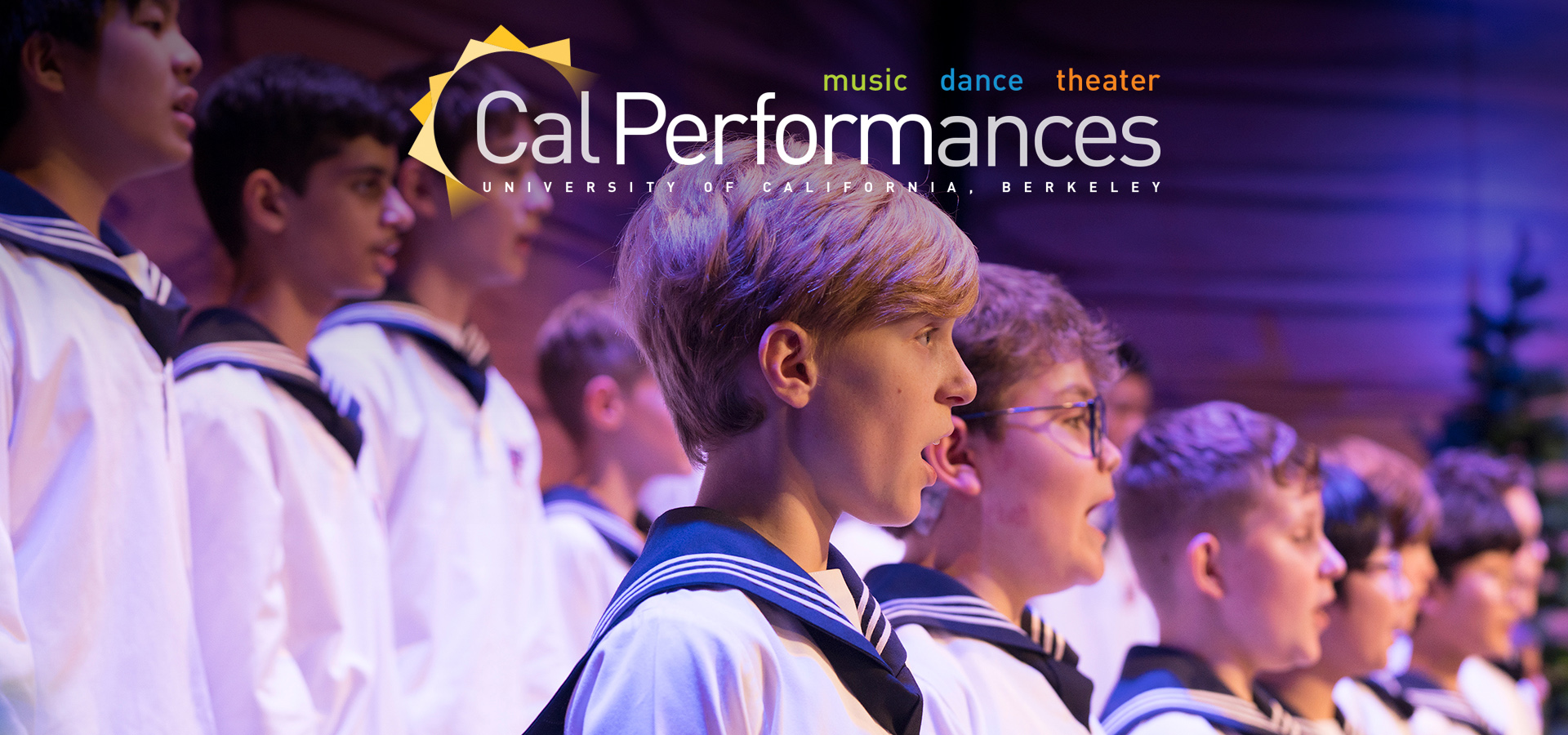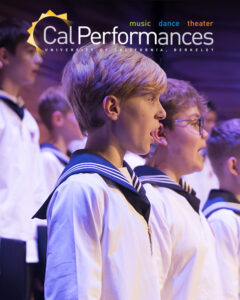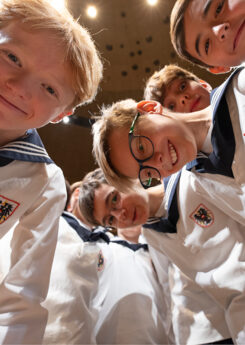Jacobus Gallus
Confirma hoc Deus (Confirm this, oh God)
Words: Psalm 68(67):29
for four voices a cappella
Gallus was born in Reifnitz, Carnolia (now Ribnica, Slovenia). His birth name was Petelin, which in Slovenian means “rooster.” As he traveled all over the Habsburg Empire, he used either the German—Handl—or the Latin—Gallus—form of his name, sometimes adding the adjective “Carniolus,” in reference to his home country.
Gallus was educated at the Cistercian monastery at Stična. He arrived in Austria as a teenager, singing first in the Benedictine Abbey at Melk and later with the Chapel Imperial in Vienna. It appears that some of his works were written for the Imperial choristers. Between 1579 and 1585, Gallus was Kapellmeister to the bishop of Olmütz (now Olomouc) in Moravia, before becoming the organist of the church sv. Jan na Zábradlí in Prague. In Prague, Gallus oversaw the systematic publication and printing of his works. His output was huge: more than 500 sacred and secular works are attributed to Gallus. He died in 1591.
Gallus’ music combines ideas and elements of the Franco-Flemish, German, and Italian Renaissance styles. Some of his chromatic transitions in particular hint at much later styles of music. Contemporaries admired his works for their beautifully woven counterpoint and compared him to Palestrina (1525–1594), high praise indeed, as Palestrina’s music was considered perfect.
Gallus differs from Palestrina in his use of rhythm. He deftly moves between double and triple meter, he uses word accents to change rhythm, and he creates moments of emotional drama and suspense, effectively painting the words. His most notable work is arguably the six part Opus musicum, 1577, a collection of 374 motets that cover the liturgical needs of the entire ecclesiastical year.
The Biblical psalm 68 (67) is attributed to King David. It describes a triumphal procession of Jahweh—his return to the rebuilt temple in Jerusalem, surrounded by musicians, dancers, and priests. Verse 29, used in this motet, confirms God as almighty. The Hebrew original could be translated literally: “Take your power, God, as befits you—the God-power, which you wield for our benefit from your temple in Jerusalem.” It would seem to indicate that God had a hand in restoring the temple. The verse goes on to say that kings—probably foreign kings—will bring gifts for the God of Israel, acknowledging Jahweh and thus proving that Jahweh protects his people. God can turn enemies into friends.
George Frideric Handel
De torrente in via bibet
(He shall drink from the stream by the way)
from Dixit Dominus, HWV 232
Words: Psalm 110:8
Arr. Oliver Stech
Handel wrote his setting of Psalm 110 (Vulgate: Psalm 109) in 1707, during his three years in Italy. The composer was only 21; this is his earliest extant piece of sacred music. It may have been commissioned by Cardinal Carlo Colonna, and was likely performed in Rome as part of the Vespers for the Feast of Our Lady of Mount Carmel that same year, conducted by Handel himself.
The psalm is both a royal and a messianic psalm; its author is King David. The first line might better be translated as “The Lord said to my master”; “Lord” refers to God, “master” to the (priest) king. The text dates to the early period of the Kingdom of Israel, ca. 1,000 BCE. The language is archaic, and the violent imagery owes much to Ancient Near Eastern texts and culture. 2,600 years on, Oliver Cromwell used it as a battle song—not what its authors had in mind.
The “master” or king in the psalm may be Melchisedek, Abraham, David, or the Messiah; in the Christian tradition, the text refers to Jesus. Psalm 110 is the most quoted text in the New Testament; Jesus himself cites it at his trial (Matthew 26:64). As a cornerstone of Christian theology, it has been set to music by Victoria, Monteverdi, Charpentier, Scarlatti, Vivaldi, Pergolesi, and Mozart—among others.
Handel’s setting of the last verse is a hauntingly beautiful duet. While the subject of the verse could be the master or king mentioned elsewhere, the sentence might also refer to the “poor man” of Psalm 109; a faithful who seeks solace in God. The words call to mind the passage in Psalm 23, “he leads me beside still waters.”
Johann Anastasius Freylinghausen
Macht hoch die Tür
(The mighty gates of earth unbar)
Text: Georg Weissel
Arr. Gerald Wirth
“Macht hoch die Tür” is a popular German advent carol used in both Catholic and Protestant churches. It was written in 1623 by Pastor Georg Weissel for the consecration of Altrossgarten Church, East Prussia. The words refer to Psalm 24, which talks about opening the temple gates to the ark of the covenant and thus to God. “Macht hoch die Tür” is a call for the congregation to receive triune God. Jesus in particular is addressed as intermediary between God and mankind. The lyrics convey a longing for eternal bliss, typical of the Baroque period. In the English speaking world, the carol is known as “Lift up your heads, ye mighty gates” (Catherine Winkworth) or as “The mighty gates of earth unbar.”
There are a number of musical settings; the Vienna Boys Choir sings the tune by Johann Anastasius Freylinghausen, a theologian and later principal of the famous Francke Foundation, a large educational campus, which at the time included an orphanage, a “paedagogium,” and a Latin school. The Francke Foundation—which is still going strong—soon had a reputation for excellence; part of the operation was a publishing house, and Freylinghausen was able to publish his hymns in a comprehensive song book.
Johann Sebastian Bach
Et exultavit spiritus meus
(And my spirit rejoices)
from Magnificat, BWV 243
Words: Luke 1:47
Born in Eisenach, Germany, Bach—one of the most famous composers of the Baroque period—held several distinguished posts as direcctor of music in various German cities. The last 27 years of his life were spent in Leipzig, as director of music of St. Thomas’ Church, tasked with providing the music for the city’s four main churches. Bach’s output as composer was enormous; and he wrote in practically every genre.
“Et exultavit” is an aria for mezzo-soprano from Bach’s famous Magnificat in D—the only Latin Marian prayer that Bach, a staunch Lutheran, ever set to music. The Magnificat is one of the oldest Christian prayers, a praise of God ascribed to Mary. The text is taken from the Gospel of Luke. Luke describes how Mary, pregnant with Jesus, visits her cousin Elizabeth, who is pregnant with John the Baptist. Elizabeth and the unborn John both recognize the presence of the unborn Christ child, which causes Elizabeth to greet Mary with a blessing. Mary responds with the Magnificat, “My soul magnifies the Lord.”
Joseph Haydn
Abendlied zu Gott
(Evening song for God)
Hob. XXVc : 9 (1796)
Words: Christian Fürchtegott Gellert
Joseph Haydn, who was mentor and friend to Mozart and Beethoven, greatly influenced the music of his time. His substantial output comprises masses, oratorios, symphonies, concerts for solo instruments and orchestra, as well as chamber music, such as string quartets, trios and piano sonatas. Already during his lifetime, Haydn was celebrated as a musical genius throughout Europe.
Haydn, son of a wheelwright, grew up in the town of Rohrau east of Vienna. When he was eight years old, Georg Reutter, director of both the Imperial Court Music and of the music at St. Stephen’s Cathedral in Vienna, visited Rohrau and heard Haydn sing. In the following years, Haydn and his younger brother Michael became choristers at St. Stephen’s and at the court. Mischievous Haydn, whose voice did not break until he was 16 years old, did not have an easy time in the choir, but he valued the education. It was the beginning of an eminent career.
The son of a protestant pastor and the fifth of 11 children, Gellert is an important exponent of the German enlightenment. He was professor of theology and philosophy at Leipzig University, where Goethe was one of his students. Gellert was held in high esteem by his contemporaries. He is noted in particular for his hymns, simple and poetic sacred poems that greatly influenced religious beliefs and thinking in the 18th century. A number of his hymns are still part of the protestant hymnal.
Max Reger
Mariä Wiegenlied (Mary’s Lullaby)
from Schlichte Weisen (Simple Melodies), Op. 76/52
Words: Martin Boelitz
Max Reger, who had his first music lessons as a child, was a student of Hugo Riemann’s (at the time an eminent composer and musicologist); Riemann’s Musiklexikon remains a household name to this day.
In 1898, during his time in the military, Reger suffered a nervous breakdown and returned home to live with his parents. In 1901, the devout catholic married a protestant divorcée. As a result, he found himself excommunicated.
Between 1901 and 1907, Reger was busy as a composer and pianist. In 1907, he was offered a professorship at the Leipzig conservatory. In 1911, he accepted the post of court composer in Meiningen; he stayed until the outbreak of World War I, and died from a heart attack in 1916.
Reger is particularly well known for his complex organ works; in fact, his music was often criticized for being overly difficult. Reger wrote his Schlichte Weisen (Simple Melodies) partly to prove his critics wrong. “Mary’s Lullaby” is dedicated to Princess Marie Elisabeth of Saxe Meiningen; it is set in F major and its swaying rhythm imitates the gently rocking of a cradle. The tune is loosely based on the old carol “Resonet in laudibus,” and the text uses Medieval imagery. The lullaby went on to become Reger’s most successful work. It is featured in Curt Faudon’s 2013 Vienna Boys Choir movie, Songs for Mary.
Benjamin Britten
There Is No Rose of Such Vertue
This Little Babe, So Few Days Old
Words: Robert Southwell
from A Ceremony of Carols, Op. 28
After three successful years in America, Benjamin Britten and Peter Pears boarded a Swedish cargo vessel, the Axel Jonsson, on the March 16, 1942 for their return to Britain. The journey took nearly a month, and the mood must have been subdued. A war was on, there were U-boats about, and the ship was not meant for passengers. Britten had intended to continue work on Hymn to St. Cecilia and a piece for Benny Goodman, but customs officials confiscated the manuscripts fearing that they might be in code for clarinet-playing Nazi spies.
During the voyage, the ship berthed at Halifax, Nova Scotia, where Britten came across a book of Medieval poems, most of them of religious content with a distinctly pagan flavor. Some of these he set during the voyage as the Ceremony of Carols, a work for boys’ choir and harp. “One had to alleviate the boredom,” Britten wrote.
The Ceremony is more than a set of jolly or sweet Christmas carols: Britten’s carefully crafted music captures the poems’ Medieval spirit and evokes the fight of light against dark, good against evil. For this year’s holiday program, the Vienna Boys Choir has selected three pieces from Britten’s cycle.
“There is no rose of such vertu” is set in F major. The rose is Mary, who, pregnant, holds an entire universe in her womb. The text alternately employs English and Latin, something that came about during the Late Middle Ages, when Christmas was exclusively celebrated in church. The Latin passages were sung by the clergy, the English by the congregation.
“This little Babe so few days old” was written by Robert Southwell, a Jesuit priest who spent much of his life in hiding. His poems had to be printed and circulated secretly. Their powerful imagery and language soon made them popular: a certain W. Shakespeare was among his readers. In the end, Southwell was captured; he was hanged in 1595, after 13 years in prison. Britten’s setting of the poem is spectacular. One voice starts it off, tentatively, this little babe having just been born. But he is here to defeat “Satan’s fold.” The baby’s weapons seem silly and weak; still, his tears and cries cause hell to quake. The voices chase one another until they reach the end: “If thou wilt foil thy foes with joy”—this is the best way to deal with your enemies—“then flit not from this heavenly boy.” The harp is used as percussion, imitating battle noises.
In the end we thank God that Adam, who represents mankind, was benighted and lay i-bounden for so long (note that the poet refers to this state of stupor as winter), simply because he had indulged in an apple. But if he had not taken the apple, there would not have been Mary, or Christ. Sometimes a rash (and not necessarily good) action can have the most surprising outcome.
Schlaf, Jesulein zart (Sleep, gentle Jesus)
Peter von Brachel Hymnal, Cologne, 1623
Arr. Micha Sengschmid
“Sleep, gentle Jesus” is a very old lullaby, with roots going back to Medieval mystery plays. It may have been performed by parishioners during or after a Christmas Eve service—Christmas in the Early Modern period was celebrated at church, with the congregation, not at home.
Peter von Brachel was the name of a printing shop in Cologne, which produced over 120 books and prints between 1600 and 1640; it probably was run subsequently by father and son, both called Peter. The original hymnal of 1623 has been lost, with partial reconstructions made from later copies. The text in this arrangement is deceptively plain and “folksy,” using everyday images in the stanzas, while hinting at the afterlife in the chorus.
Ēriks Ešenvalds
O salutaris hostia (O saving sacrifice)
Words: Thomas Aquinas
Latvian Ēriks Ešenvalds is a highly successful contemporary composer best known for his choral works. From 2011 to 2013, he served as Fellow Commoner in Creative Arts at Trinity College, Cambridge. For him, harmony is the main focus in his writing; he aims to create a truthful soundscape for each of his pieces.
“Salutaris hostia” is a hymn written by St. Thomas Aquinas for the feast of Corpus Christi, to be used during the eucharist. Ešenvalds’ setting is for two solo voices, performing over harmonies supplied by the choir.
Tomorrow Shall Be My Dancing Day
16th century carol
Arr. John Rutter
This carol goes back to Medieval times. The speaker is Jesus, who basically offers a preview of his entire biography before his birth. The line “To see the legend of my play” suggests that the carol may have been part of a mystery play, performed for the feast of Corpus Christi.
The dance here may be taken both literally and in a figurative sense—to dance is an expression of joy; to dance is to live. The “true love” is the soul of a believer, and this fits well with Medieval mysticism, where the soul is the bride and Jesus is the groom. The imagery in the song is closely related to that in “Lord of the Dance.”
God Rest Ye Merry, Gentlemen
Old English carol
Arr. Gerald Wirth
“God Rest You Merry, Gentlemen” has its roots in the 17th century: In 1650, it appears in a manuscript, in 1760, in a broadsheet. It was included in William Sandys’ seminal anthology of 1833, Christmas Carols Ancient and Modern; its author is unknown.
In 1843, the carol achieved literary fame as Dickens’ eponymous Christmas Carol: “…at the first sound of ‘God bless you merry, gentlemen! May nothing you dismay!’—Scrooge seized the ruler with such energy of action that the singer fled in terror, leaving the keyhole to the fog and even more congenial frost.” George Eliot refers to it in her 1861 novel, Silas Marner.
The gentlemen in the title are not merry, they are supposed to “rest merry”; in Shakespeare’s time, “God rest you merry” would have been a normal greeting, as in “May God grant you peace,” much like “Shalom” today. It is possible that the carol was sung by the town waits in 18th- and 19th-century England. Originally, waits were town guards; in the 15th and 16th centuries, they were simultaneously employed as town musicians, performing at public functions. It was customary for the waits to visit the houses of the “gentlemen” of their town at Christmas, a practice that survives to this day. There are still waits carolling in English towns and villages.
La virgen lava pañales
(The virgin washes the swaddling clothes)
Traditional villancico from Spain
Arr. Robert DeCormier
This traditional Spanish carol is a so-called villancico; a song in stanzas with a chorus, usually on a rustic theme. The form dates back to the 15th century. Villancicos became popular in the 16th and 17th centuries; religious villancicos like this one often explain Biblical themes in everyday imagery and settings. “La virgen lava pañales” shows Mary and Jesus as humans, pure and simple and at the same time extraordinary, whose mere touch makes nature happy, turns nature into paradise.
Hugo Blanco
El burrito de Belén
(The little donkey from Bethlehem)
Villancico from Venezuela
Hugo Blanco composed his villancico carol in 1972. The cheerful little song about a boy and his little donkey is extremely popular in Latin America, possibly due its bouncy merengue rhythm. “Cuatrico” is a diminutive for the cuatro, a type of four-stringed guitar used in Venezuelan folk music.
Blanco is best known for his songs, among them “Moliendo Café,” sung by football fans around the world, and “La vecina” (“The neighbor”), which was used in an episode of Miami Vice.
Ein Kind geboren gar wunderschön
(A beautiful child is born)
Sacred lullaby from Lower Austria
Arr. Gerald Wirth
Sacred lullabies are a typical form of Christmas carols in the Alps; most were written for Christmas pageants performed on Christmas Eve, by parishioners.
Still, still, still (Softly, softly, softly)
Sacred lullaby from Salzkammergut
Arr. Gerald Wirth
“Still, still, still”—another lullaby—appeared first in print in Salzburg in 1819, but has a much older oral tradition. The carol’s gentle rhythm perfectly captures the rocking of a cradle.
Am Weihnachtsbaum die Lichter brennen
Folk song from Saxony and Thuringia, Germany
Words: Gustav Hermann Kletke (1813–1886), 1841
Arr. Gerald Wirth
Hermann Kletke was a journalist, writer, and poet, originally from Silesia. In 1838, he became editor of the Vossische Zeitung, at that time the most important newspaper for the bourgeoisie in Berlin. Around 1840, he penned “Am Weihnachtsbaum”; the poem was sung to an older tune popular in Thuringia and Saxony. The words reflect the atmosphere in 19th-century German households; and there is no mention of the birth of Christ.
In the 1820s, the custom of putting up a decorated fir tree at home for Christmas became popular in Germany; adding candles was a luxury only the rich could afford. The tree itself was seen as a symbol of constancy, hope, and life. Its leaves do not change color, and green is the color traditionally associated with fidelity and trust, with new beginnings, spring and hope. In the Middle Ages, green was a sign of love, and the German idiom “jemandem grün sein” (to “be green” towards someone) means to like them.
Eduard Ebel (1839–1905)
Leise rieselt der Schnee (Softly falls the snow)
Arr. Gerald Wirth
Ebel, a theologian, wrote this song around 1900; he uses wintry images to conjure up a Christmassy landscape, and emotions to go with it. The spirit of Christmas, then, helps to keep your cares at bay—and everyone looks forward to the coming of the Christ child, who brings peace.
The song and text are somewhat corny, but cling to memory, and as with many such songs, there are countless parodies, some mocking everyday matters such as schoolwork, some specific political events in Germany.
In German-speaking countries, both Saint Nicholas and the Christ child might bring the gifts at Christmas; the Christ child as bringer of gifts was allegedly thought up by Martin Luther, to counter the Catholic veneration of Saint Nick while maintaining the rather useful custom of giving gifts to each other. Nowadays, the Christ child is pretty popular in most German-speaking countries, regardless of denomination.
Pat Ballard
Mister Santa
Arr. Ed Lojeski
“Mister Santa” is, as it were, the holiday version of Ballard’s 1954 hit “Mister Sandman,” requesting the figure from German folklore to bring pleasant dreams, or perhaps real-life dreams in human form. A version sung by the Chordettes became a number one hit in the US, and another by the Four Aces reached the Top 10—and was famously featured in the movie “Back to the Future.” In 1981, Emmylou Harris recorded it; her version proved a hit in several countries.
Meryvn Warren and Hallerin Hilton Hill
“Who Would Imagine a King,”
from the 1996 film The Preacher’s Wife
Arr. Keith Christopher
“Who Would Imagine a King” was originally written for Penny Marshall’s 1996 holiday comedy, starring Denzel Washington as an angel with the unlikely name Dudley, and Whitney Houston as the preacher’s wife, who is a star in her husband’s church choir. The film’s subplot involves the choir, and gives Houston the opportunity to sing a number of gospel hits and stunning solos, including “Who Would Imagine.” The film was nominated for the Oscar for Best Music.
Sir John Goss
See, amid the Winter’s Snow
Text: Edward Caswall
Arr. Dan Forrest
English clergyman Edward Caswall wrote his “Hymn for Christmas” in 1858, after his conversion from the Church of England to Roman Catholicism. In 1871, the composer John Goss, who was organist at St. Paul’s Cathedral in London, wrote the music to fit the words; he named the tune “Humility.” The carol was included in the seminal carol collections of Henry Bramley and John Stainer, and quickly became popular…so popular, in fact, that it has been used in a number of political protest songs in England and Canada.
Traditional Spiritual
Go, Tell It on the Mountain
Arr. Michael Engelhardt
“Go, Tell It on the Mountain” is an old African-American spiritual, and a Christmas classic. It dates back to at least 1865, when it was written down by choir director John Wesley Work. Work’s son, John Work II, probably wrote down the current lyrics, and Work’s grandson, John Work III, published it in its current form in a 1948 anthology. It has been covered countless times and even made its way into the German protestant hymnal as “Komm, sag es allen weiter.”

 This month, Cal Performances’ 2022–23 season shifts into high gear! Our carefully curated, season-long Illuminations programming (see below for details) continues with visits from new-music champions the Colin Currie Group (with Synergy Vocals) and Sō Percussion, and our classical music offerings are distinguished by appearances by acclaimed soprano Ying Fang (with pianist Ken Noda), early-music superstars (and Berkeley favorites!) Jordi Savall and his renowned Hespèrion XXI ensemble, and an astonishing young talent, cellist Zlatomir Fung (with pianist Janice Carissa). We’ll also enjoy a special Vocal Celebration, with three concerts honoring the otherworldly beauty of Georgian polyphony (Ensemble Basiani), the inspirational power of freedom songs from both South Africa and the United States (Soweto Gospel Choir), and—in a joyous launch of the upcoming holiday season—the heart-warming sounds that spring from Austria’s august six-century-old choral tradition (Vienna Boys Choir).
This month, Cal Performances’ 2022–23 season shifts into high gear! Our carefully curated, season-long Illuminations programming (see below for details) continues with visits from new-music champions the Colin Currie Group (with Synergy Vocals) and Sō Percussion, and our classical music offerings are distinguished by appearances by acclaimed soprano Ying Fang (with pianist Ken Noda), early-music superstars (and Berkeley favorites!) Jordi Savall and his renowned Hespèrion XXI ensemble, and an astonishing young talent, cellist Zlatomir Fung (with pianist Janice Carissa). We’ll also enjoy a special Vocal Celebration, with three concerts honoring the otherworldly beauty of Georgian polyphony (Ensemble Basiani), the inspirational power of freedom songs from both South Africa and the United States (Soweto Gospel Choir), and—in a joyous launch of the upcoming holiday season—the heart-warming sounds that spring from Austria’s august six-century-old choral tradition (Vienna Boys Choir).



